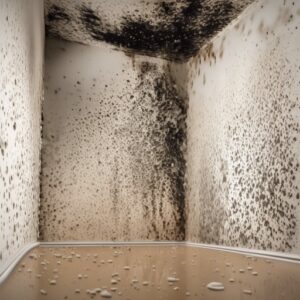Nestled within the vibrant landscape of Southern California, Orange County boasts a rich agricultural heritage. From sprawling citrus groves to quaint family farms, the region’s agricultural sector contributes significantly to its cultural identity and economy. However, like any farming community, Orange County’s agricultural enterprises are not immune to the challenges posed by environmental factors, including mold infestations.
In this article, we delve into the intricacies of mold remediation in Orange County farms. We’ll explore the conditions that make farms susceptible to mold growth, the potential consequences of mold infestations, and proactive measures farmers can take to address and prevent these issues.
Understanding Mold Growth on Farms
Mold is a type of fungus that thrives in damp, humid environments, making agricultural settings particularly vulnerable to its proliferation. Orange County’s Mediterranean climate, characterized by mild, wet winters and hot, dry summers, creates conditions conducive to mold growth, especially during the cooler months.
Farms, with their diverse array of crops, livestock, and structures, provide ample opportunities for mold to take hold. Factors such as poor ventilation, water leaks, and organic matter decomposition can create ideal breeding grounds for mold spores. Additionally, the presence of moisture-retaining materials like hay, straw, and wood can exacerbate the problem.
Consequences of Mold Infestations
Mold infestations pose significant risks to both crop yields and livestock health. Mold can contaminate agricultural products, rendering them unsuitable for consumption or sale. Fruits, vegetables, and grains are particularly susceptible to mold growth, leading to spoilage and economic losses for farmers.
Moreover, mold exposure can adversely affect animal health, leading to respiratory issues, allergic reactions, and decreased productivity. Livestock housed in mold-contaminated barns or fed moldy feed are at risk of developing serious health problems, jeopardizing both animal welfare and farm profitability.
In addition to economic repercussions, mold infestations can also tarnish a farm’s reputation and compromise food safety standards. Contaminated produce or products can lead to consumer complaints, recalls, and regulatory scrutiny, undermining consumer confidence in the farm’s brand.
Signs of Mold Infestations on Farms
Identifying mold infestations early is crucial for effective remediation. Farmers should be vigilant for common signs of mold growth, including:
- Visible mold growth on surfaces, such as walls, ceilings, and equipment.
- Musty or earthy odors emanating from feed storage areas, silos, or livestock housing.
- Discoloration or deterioration of crops, feed, or structural materials.
- Increased incidence of respiratory issues or allergic reactions among farm workers or animals.
Regular inspections and proactive monitoring can help farmers detect mold problems before they escalate, minimizing damage and remediation costs.
Mold Remediation Strategies for Farms
When faced with mold infestations, prompt and thorough remediation is essential to safeguard farm operations and mitigate risks. Mold remediation efforts typically involve the following steps:
- Identification of the mold species and extent of the infestation through professional assessment and testing.
- Implementation of containment measures to prevent further spread of mold spores.
- Removal and disposal of mold-contaminated materials, such as spoiled crops, feed, bedding, and structural components.
- Cleaning and disinfection of affected surfaces using appropriate fungicidal agents and techniques.
- Implementation of moisture control measures, such as improved ventilation, drainage, and waterproofing, to prevent future mold growth.
- Monitoring and ongoing maintenance to prevent recurrence of mold infestations.
Engaging qualified mold remediation professionals with expertise in agricultural settings is crucial for ensuring effective and compliant remediation efforts. These professionals can assess the unique challenges and vulnerabilities of farm environments and tailor remediation strategies accordingly.
Preventative Measures for Mold Control
In addition to reactive remediation measures, farmers can adopt proactive strategies to minimize the risk of mold growth on their properties:
- Maintain proper ventilation and humidity levels in barns, storage facilities, and other enclosed spaces.
- Promptly repair any leaks or water damage to prevent moisture buildup.
- Store crops, feed, and bedding in dry, well-ventilated areas away from potential sources of moisture.
- Regularly clean and inspect equipment, surfaces, and structures for signs of mold growth.
- Implement integrated pest management practices to prevent pest infestations, which can exacerbate mold problems.
- Educate farm workers on mold awareness, prevention, and response protocols to promote a culture of proactive management.
By adopting a holistic approach to mold control, farmers can protect their investments, uphold food safety standards, and ensure the long-term sustainability of their operations.
Conclusion
Mold remediation Orange County CA is a critical consideration for Orange County farms, given the region’s climate and agricultural diversity. Mold infestations can have far-reaching consequences, affecting crop yields, livestock health, and farm profitability. However, by understanding the factors contributing to mold growth, recognizing the signs of infestation, and implementing proactive remediation and prevention strategies, farmers can effectively manage mold-related risks and safeguard their operations.
As stewards of the land, Orange County farmers play a vital role in maintaining the integrity and resilience of the region’s agricultural landscape. By prioritizing mold remediation and embracing sustainable practices, they can continue to thrive in harmony with nature, ensuring a prosperous future for generations to come.


